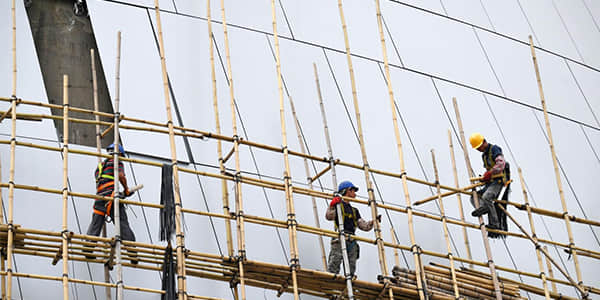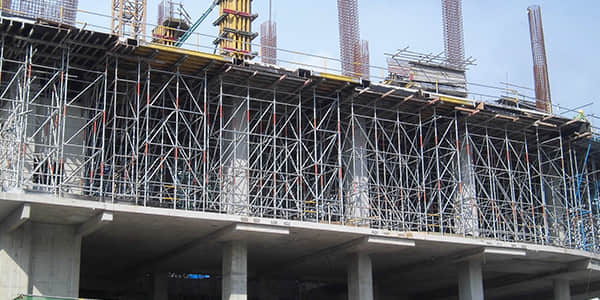Échafaudages en bambou ou en acier : un guide complet sur la sécurité, les coûts et la durabilité
Aug 14, 2025
Tout projet moderne, quelle que soit son échelle (c'est-à-dire d'une tour verticale à une petite maison), nécessite échafaudage. Le monde d'aujourd'hui pourrait suggérer que l'acier est la méthode contemporaine de construction, mais le bambou est certainement plus traditionnel, et pourtant couramment utilisé dans la plupart des pays du monde. Il ne s'agit pas d'opposer les pratiques courantes aux pratiques modernes ; il s'agit des possibilités d'ingénierie, de sécurité et de coûts liées à la différence de matériau.
Cet article fournit une représentation comparative du bambou et échafaudages en acier en termes d'avantages, d'inconvénients et de meilleures utilisations, qui est fourni dans le but de fournir au professionnel de la construction, au chef de projet ou à l'ingénieur les informations nécessaires pour prendre une décision utile en fonction des informations, de la sécurité et de la durabilité de leur projet.

Le bambou est un matériau de construction essentiel en Asie depuis des siècles. Son utilisation intensive (souvent dans les environnements urbains les plus peuplés, comme Hong Kong) est étroitement liée à ses propriétés intrinsèques et aux nombreux savoir-faire de nombreux constructeurs de renom.
Bien que les échafaudages en bambou présentent des avantages, ils présentent également des inconvénients. Les progrès en matière de sécurité et de stabilité structurelle dépendent de la qualité de la matière première ainsi que des connaissances et des compétences de l'équipe chargée de la construction. Compte tenu de l'absence de système de classification du bambou et de la nature imprévisible et incertaine des aléas climatiques (humidité et nuisibles), il est difficile de prédire à la fois les performances et la sécurité.

L'omniprésence des échafaudages en acier comme norme de la communauté de la construction dans les bâtiments contemporains est sans aucun doute attribuable à systèmes d'échafaudages en acier répondant aux exigences strictes des normes de sécurité et d'ingénierie.
Échafaudages métalliquesLes principaux inconvénients d'un échafaudage sont son coût initial élevé et son poids. En raison du coût des matériaux, l'investissement initial est plus élevé. Le poids de l'acier correctement monté doit généralement être transporté et installé sur un échafaudage. Cela implique des coûts d'équipement plus élevés, et la logistique et la complexité du projet peuvent dépasser celles de l'échafaudage.
Le tableau suivant fournit une comparaison directe des attributs clés pour faciliter une compréhension globale des deux systèmes.
Fonctionnalité | Échafaudages en bambou | Échafaudages en acier |
Sécurité et intégrité structurelle | Dépend de la qualité du matériau et de l'artisanat, non standardisé. | Conçu selon des normes internationales strictes, il offre une stabilité prévisible et fiable. |
Implications financières | Coûts initiaux de matériaux et de main-d'œuvre réduits. Les coûts à long terme peuvent augmenter en raison des remplacements fréquents. | Dépenses d'investissement initiales plus élevées. Offre une plus grande valeur à long terme grâce à la durabilité et à la réutilisabilité. |
Durabilité et durée de vie | Durée de vie courte ; vulnérable à la dégradation de l’environnement et aux parasites. | Exceptionnellement durable ; conçu pour une durée de vie prolongée et une utilisation répétée. |
Poids et logistique | Léger et facilement manipulable manuellement ; logistiquement simple. | Lourd et encombrant ; nécessite une assistance mécanique pour le transport et le montage. |
Montage et démontage | Montage rapide et manuel par des ouvriers qualifiés. | Processus plus lent et méthodique nécessitant du personnel qualifié et le respect des protocoles. |
Profil de durabilité | Très durable grâce à une croissance rapide et un traitement minimal. | Durable et recyclable, sa production est cependant gourmande en énergie. |
Application optimale | Projets de faible hauteur et de courte durée dans des régions où la main-d’œuvre qualifiée et les matériaux sont disponibles. | Projets de grande hauteur, à grande échelle, à long terme et complexes, avec des exigences strictes en matière de sécurité et de réglementation. |
Le choix entre un échafaudage en bambou et un échafaudage en acier est une décision stratégique cruciale qui doit être guidée par une analyse approfondie des spécifications du projet et des contraintes opérationnelles. Aucun des deux matériaux n'est intrinsèquement supérieur ; chacun offre au contraire des avantages distincts, adaptés à des contextes spécifiques.
L'échafaudage en bambou est un choix pratique et judicieux pour les travaux dont les principaux facteurs sont le coût et la rapidité d'exécution (à condition de respecter les réglementations locales en matière de construction et de disposer d'une main-d'œuvre qualifiée). Il est particulièrement adapté aux petits travaux, où ses capacités uniques peuvent être exploitées.
Échafaudages en acier C'est la seule option pour tout ouvrage où la sécurité, la durabilité et le respect des obligations légales sont des critères primordiaux. C'est la solution idéale pour les constructions de grande hauteur, les projets d'infrastructures de grande envergure et tout autre ouvrage où l'intégrité de la structure ne peut être compromise.
En fin de compte, le choix du matériau d’échafaudage doit être une décision éclairée, équilibrant les facteurs économiques, les considérations environnementales et, surtout, l’impératif de garantir un environnement de travail sûr et sécurisé.
1. Les échafaudages en bambou sont-ils sûrs ?
2. Les échafaudages en acier sont-ils plus chers que ceux en bambou ?
3. Quel est l’impact environnemental de chaque matériau ?
4. Les échafaudages en acier et en bambou peuvent-ils être utilisés ensemble ?